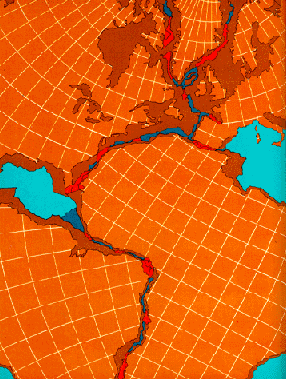Dinosaurs, conifers and flowering
plants.
The opening of the Atlantic...
| Timeline
4 - 250 million
years ago to present |
|
www.fsnielsen.com -
return to graphic - previous
- next -
The
great event in this period is undoubtedly the opening up the Atlantic
Ocean - a slow process, that is still going on, starting, perhaps, with
initial conditions not dissimilar to those at present obtaining in the
Rift Valley in East Africa. It was the visible correspondence of the
American and Eurafrican continental borders that supplied Alfred Wegener
with his first clue to the theory
of continental drift, which he proposed in 1915. Though considered
ridiculous at the time, it is today unanimously accepted by geologists
and geophysicists. Later research has shown that the opening of the
Atlantic was only a part of a far larger and more impressive global
process - the breakup of the supercontinent Pangea:
|

Africa,
Europe, and North and South America, before the opening of the Atlantic
Ocean (ca. 200 mill. years ago)
|
|
|
It is on this background that the
other events of this period must be seen: A single, continental mass, with its
vast, dry and cold interior expanses, was supplanted by many, spread-out island
continents, with wetter and more varied climates. The rifting process also led
to a parting of ways for many species of flora and fauna, particularly in the
Sounthern hemisphere, which from now on developed in disperate ways on the South
American, African and Australian continental isolates.
The period opens with the next to
last Great Extinction before our time, which killed off (among countless other
species) the trilobytes, but left the scenes open for an explosive development
of reptiles into giant reptiles: dinosaurs. Dinosaurs "reigned the world"
for some 130 million years, until the next (and as we speak last) Great Extinction
in global history, when they were killed off.
Towards the end of the period we
see a world forming that is populated by more familiar species: conifers, flowers,
birds, mammals. The two latter groups emerged only after the last great extinction,
and seem yet another proof that these events have indeed stimulated biological
diversification. As we shall see, a similar role may be played by the smaller
extinctions caused by ice-ages in recent years.
Towards the end of the period we
also see the buildup to the last great mountain-folding process in global history:
this was when all "modern" mountains arose - the Alps and the Himalayas,
the South American Sierras and the North American Rockies. And with more mountains
come colder weather again.
Sources

